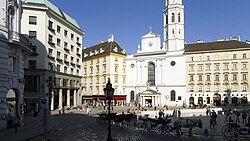Michaelerplatz
The Michaelerplatz in Vienna is conceived around 1725, but realized only at the end of the 19th century baroque star space in the city center.
history

The square has been named after Duke Leopold VI of Babenberg since 1850 . donated parish church St. Michael for the court servants and the citizens who lived in the vicinity of the Hofburg . The square, which has been extremely irregular for centuries, was redesigned around 1725 by the plans of Joseph Emanuel Fischer von Erlach for the Michaeler tract of the Hofburg. Construction work on the left wing began in 1729, but stagnated during the final years of the reign of Emperor Charles VI. and were discontinued in 1741 after Maria Theresa had rededicated the ballroom to a theater. The baroque plans were not implemented until about 150 years later, namely from 1889 to 1893 by Ferdinand Kirschner , in connection with the demolition of the old Burgtheater in the middle of the square .
In autumn 1838 Vienna's first public gas lighting was installed at Michaelerplatz . The entrepreneur Georg Pfendler , founder and director of the "Austrian Society for Lighting with Gas", set up a gas candelabra with six flames on the square . The gas came from the Roßau gasworks via a pipe . In 1927 Vienna's first roundabout was set up at Michaelerplatz .
Notable buildings
A number of remarkable buildings are grouped around Michaelerplatz. In addition to the already mentioned Michaeler tract of the Hofburg (Michaelerplatz 1, with a dome over the passage to the Burgtor), which was conceived as the dominant feature of the line of sight of the Kohlmarkt , the Looshaus, which was built at the beginning of the 20th century according to designs by Adolf Loos and was heavily controversial at the time , is particularly important (Michaelerplatz 3). The so-called Palais Herberstein (Michaelerplatz 2), a neo-baroque Zinspalais instead of the old Palais Dietrichstein-Herberstein , tries to adapt to the style of the Michaelertrakt. Michaelerkirche can be regarded as one of the most historically and culturally significant church buildings in Vienna . Historically assigned to it are the Great Michaelerhaus (Michaelerplatz 4) built by the Barnabites, built in 1720 by Giovanni Battista Maderna , and the Kleine Michaelerhaus (Michaelerplatz 6), built in 1732. The church in between bears the number 5.
The center of Michaelerplatz has been defined by excavated archaeological excavations since 1991, which are permanently accessible to the public as a branch of the Wien Museum and were framed by the architect Hans Hollein .
literature
- Richard Bösel, Christian Benedik, Kulturkreis Looshaus, Graphic Collection Albertina (eds.): Michaelerplatz in Vienna: Its urban and architectural development (exhibition guide). Looshaus culture group, Vienna 1991
- Forschungsgesellschaft Wiener Stadtarchäologie (Ed.): Find location Vienna: Reports on Archeology Vienna 2002 (including a detailed report on the excavations at Michaelerplatz)
- Christine Ranseder - Sylvia Sakl-Oberthaler et al., Michaelerplatz. The archaeological excavations , Vienna Archaeological 1. (2nd, revised and expanded edition, Vienna 2011) ISBN 978-3-85161-046-8
Web links
Individual evidence
- ↑ First gas lighting in Vienna at www.wiener-gasometer.at ( Memento of the original dated May 30, 2009 in the Internet Archive ) Info: The archive link was inserted automatically and has not yet been checked. Please check the original and archive link according to the instructions and then remove this notice. , accessed February 14, 2010
Coordinates: 48 ° 12 '28.7 " N , 16 ° 21' 59.1" E



